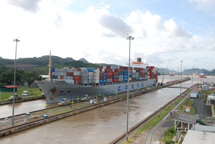 |
 |
|
| eNews • January 2011 | ||
| Promoting a Cost-Effective, Reliable and Competitive Transportation System |
||
 Soy Transportation Coalition Tours Panama Canal
Soy Transportation Coalition Tours Panama Canal
The board of directors of the Soy Transportation Coalition (STC) and other soybean industry leaders toured the Panama Canal in conjunction with the organization’s annual meeting on Dec. 15-16, 2010. The purpose of the visit was to see firsthand the Panama Canal in operation as well as receive an update on the progress of the canal expansion project.
"Soybean production is increasingly a global industry,” says Mike Steenhoek, executive director of the Soy Transportation Coalition. “The profitability of soybean farming is therefore not only dependent on supply and demand. It also depends on the logistics system that connects the two. The Panama Canal is a significant link in our global logistics chain that allows U.S. agriculture to remain competitive.”
The group visited the Panama Canal lock chambers and witnessed a number of ocean vessels transit the canal. The group also met with officials from the Panama Canal Authority to discuss the importance of the canal to U.S. agricultural exports and to hear an update on the canal expansion project. During the trip, the Soy Transportation Coalition group rode on the Panama Canal Railway from its station near the Pacific Ocean to its terminal near the Atlantic Ocean – a fifty mile journey made in little over an hour.
Completed in 1914, the Panama Canal is an important artery for the U.S. economy. Forty percent of the cargo that transits the canal originates in the U.S. Twenty seven percent is destined to the U.S. Forty-two percent of U.S. grain exports transit the canal. Approximately 550 million bushels of soybeans were shipped through the canal in 2010 – the largest volume among U.S. agricultural commodities.
While much investment over the years has been allocated for canal operations and maintenance, the number and size of the lock chambers have remained the same since the canal’s opening. Currently many of the largest ocean vessels exceed the size of the canal locks. To maintain its role as a key artery for global commerce in the future, the Panama Canal Authority determined to expand the canal.
The expansion project involves the construction of a new set of locks – doubling the size of ships able to transit the canal. The project is scheduled to be completed in 2014 at a cost of $5.2 billion.
"The Panama Canal Authority was pleased to host the Soy Transportation Coalition," explains Maria Sanchez, Coordinator of Traffic Projections for the Panama Canal Authority. "The country of Panama is making a sizable investment to ensure that the Panama Canal remains a pivotal artery for the global logistics chain. We are hopeful that the United States - the leading user of the Panama Canal - will make the necessary investments in their own infrastructure to ensure the canal expansion will be of benefit to the U.S. economy and not a source of congestion. Given the importance of the canal to U.S. agricultural exports, we are encouraged to see soybean farmers become active in this important issue. The Panama Canal Authority looks forward to working with the Soy Transportation Coalition in the future."
Soy Transportation Coalition |
|
